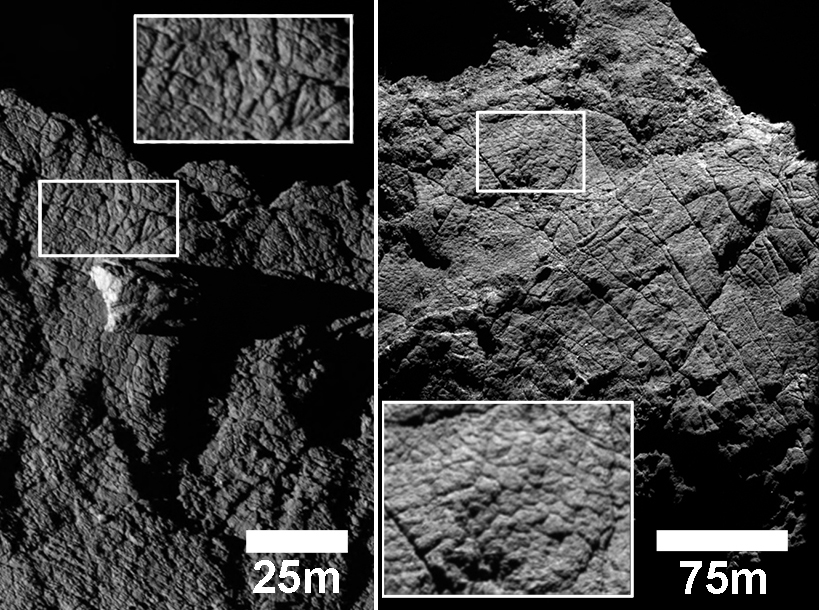Source: Geophysical Research Letters
Since the Rosetta spacecraft first started to orbit around the duck-shaped comet known as 67P/Churyumov-Gerasimenko on 6 August 2014, it has sent back stunning, high-resolution photos of the comet surface. These black-and-white images show a surface that is anything but smooth; 67P’s surface is littered with divots, boulders, cracks, and crags. The origin of these geological features and what they might tell us about the comet’s formation and composition has been of great interest to scientists. Here El-Maarry et al. provide an analysis of the different types of fractures found on 67P’s surface.
The team describes three different types of fractures: polygonal networks, fractured escarpments, and fractured boulders. Polygonal networks, which resemble the bottom of a dried lake bed or patterned ground in Earth’s high latitudes, are typically found on the flat surfaces on the comet, and the cracks are arranged in relatively dense networks that create the eponymous polygons as they intersect and branch.
The fractured escarpments occur primarily at the edges of steep cliffs that connect terrain of two different heights (escarpments) and are found mostly in the Seth region of 67P. The fractured boulders are exactly what their name suggests—large cracks in boulders on the comet’s surface, some of which even break the rocks down into smaller parts.
The team believes that all three of the different fracture features are likely caused by the rapid heating and cooling of 67P’s surface coupled with very high temperature differences between night and day. These temperature fluctuations can be caused by both diurnal heating cycles as the comet spins in relation to the Sun and seasonal variations as it gets closer to or farther from the Sun. In the case of polygonal networks, the scientists speculate that the presence of volatile compounds—probably water ice—below the surface might give rise to the fracture pattern.
In addition to the three types of cracks outlined above, the team also analyzed three large-scale features on the comet: the Anuket feature, the Aker feature, and the Hathor feature. The Anuket feature is a single ~500-meter-long fracture near the “neck” region of 67P (in keeping with the duck shape analogy). Because of its length and isolation from other fracture features, the team predicts that the Anuket feature may be the result of orbital forces that are experienced most acutely in the neck region. Similarly, the Aker feature is an ~200-meter-long angular fracture system also found in the neck region and also suspected to be a product of stresses from orbital forces.
Finally, the Hathor feature consists of parallel cracks in a cliff that bears the same name. Unlike the other features, the team postulates that the Hathor feature may have arisen from collision forces possibly dating all the way back to 67P’s formation, as it coalesced from debris orbiting the Sun at a distance greater than Neptune.
The team points out that their results are preliminary and will need to be confirmed with models and simulations of comet conditions in the laboratory. (Geophysical Research Letters, doi:10.1002/2015GL064500, 2015)
—David Shultz, Freelance Writer
Citation: Shultz, D. (2015), Cracks on comets most likely caused by thermal stress, Eos, 96, doi:10.1029/2015EO037675. Published on 21 October 2015.
Text © 2015. The authors. CC BY-NC 3.0
Except where otherwise noted, images are subject to copyright. Any reuse without express permission from the copyright owner is prohibited.

